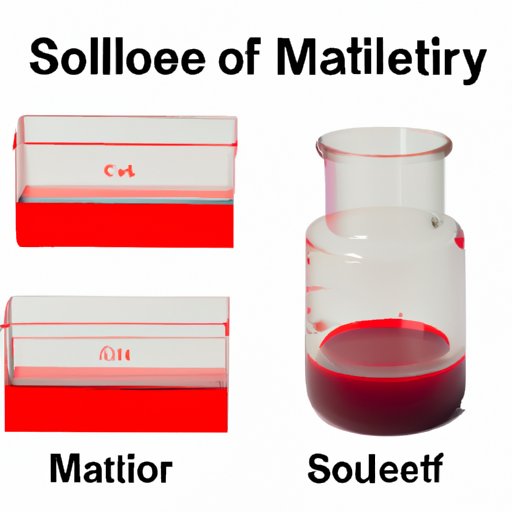
Introduction
Molarity is a measure of the concentration of a solution. It is an essential concept in chemistry, and it is crucial in laboratory analysis. Molarity helps to determine the amount of a substance required for a particular reaction. In this article, we will provide a comprehensive guide on how to find molarity, using simple language and examples. We will also discuss the importance of molarity in laboratory analysis and its real-world applications.
Step-by-Step Guide: How to Find Molarity
The formula for finding molarity is:
Molarity (M) = Moles of solute (n) / Volume of solution (V) in liters
To find the molarity of a solution, you will need the following:
- Mass balance or scale
- Graduated cylinder or volumetric flask
- Solute
- Solvent
Here is the step-by-step process to determine the molarity of a solution:
- Weigh the required amount of solute using a mass balance or scale.
- Add the solute to a volumetric flask.
- Add distilled water to the volumetric flask up to the required volume.
- Mix thoroughly until the solute has dissolved in the solvent.
- Determine the volume of the solution using a graduated cylinder or volumetric flask.
- Calculate the molarity using the formula above.
For example:
What is the molarity of a solution containing 0.25 moles of solute in 500 mL of solvent?
M = n/V = 0.25 moles / 0.5 L = 0.50 M
Visual Aids: Explaining Molarity Using Imagery
Diagrams and charts are helpful in simplifying the concept of molarity. For instance, a bar graph can be used to illustrate the concentration of a solution. A line graph can show how the concentration changes over time. Alternatively, a pie chart can show the percentage composition of a solution.
Here are some scenarios in which finding molarity comes in handy:
- Preparing solutions with specific concentrations
- Diluting solutions to specific concentrations
- Calculating the number of moles of a solute in a solution
Below are some images and diagrams that illustrate these scenarios:



Problem-solving Approach: Posing Scenarios and Offering Solutions
Here are some scenarios that require finding molarity:
Scenario 1: You need to prepare 500 mL of a 0.1 M solution of NaCl.
Solution:
- Determine the number of moles of NaCl required.
- Calculate the mass of NaCl required using the molar mass.
- Add the required amount of NaCl to the volumetric flask.
- Add distilled water to the volumetric flask up to the required volume.
- Mix thoroughly until the NaCl has dissolved in the solvent.
Scenario 2: You have a 0.2 M solution of NaCl, and you need to prepare a 0.05 M solution.
Solution:
- Determine the volume of the 0.2 M solution required to prepare 500 mL of 0.05 M solution.
- Calculate the volume of distilled water required to dilute the 0.2 M solution.
- Add the distilled water to the volumetric flask first.
- Add the 0.2 M NaCl solution to the volumetric flask.
- Mix thoroughly.
Scenario 3: You need to prepare 200 mL of a 0.3 M solution of HCl from a 6 M stock solution.
Solution:
- Determine the number of moles of HCl required.
- Calculate the volume of the stock solution required using the formula C1V1 = C2V2.
- Add the required volume of the stock solution to the volumetric flask.
- Add distilled water to the volumetric flask up to the required volume.
- Mix thoroughly until the HCl has dissolved in the solvent.
Real-world Examples: Molarity in Everyday Life
Molarity is used in everyday life for various applications. For example:
- Fertilizer solutions require a specific concentration of nutrients for optimal plant growth.
- The molarity of bleach is crucial in determining its disinfectant properties.
- The precise concentration of medicines is essential to ensure their therapeutic effect.
- The concentration of acids and bases is critical in industrial processes and cleaning products.
Here is an example of how to find the molarity of bleach:
Scenario: You have a solution of bleach with a concentration of 5% sodium hypochlorite by volume. What is the molarity of the solution?
Solution:
- Determine the molar mass of sodium hypochlorite, which is NaClO.
- Calculate the number of moles of NaClO in 100 mL of bleach solution.
- Calculate the volume of the solution in liters.
- Calculate the molarity of the bleach solution.
The molarity of the bleach solution is 0.22 M.
Interactive Approach: Engaging the Readers
To engage readers and help them learn how to find molarity through practice, we can incorporate interactive tools such as quizzes and calculators. The quiz questions can cover the different scenarios presented earlier, and the calculator can provide readers with a step-by-step process to calculate molarity.
Conclusion
In conclusion, understanding how to find molarity is crucial in laboratory analysis and everyday life. This article has provided a step-by-step guide to calculate molarity, explained the importance of molarity, illustrated molarity using visual aids, and offered solutions to various scenarios. It has also presented real-world examples of how molarity is used in everyday life and suggested interactive tools to help readers practice finding molarity.
Reference List
1. De Leon, N., & Vizuete, K. (2013). Laboratory manual for principles of general chemistry. John Wiley & Sons.
2. Chang, R. (2014). Chemistry. McGraw-Hill Higher Education.
3. Zumdahl, S. S., & Zumdahl, S. A. (2017). Chemistry. Cengage Learning.




